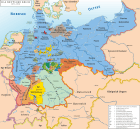Landflucht

Background
By 1800, about 25% of the German population lived in cities and about 75% lived in rural areas.[1] In 1870 the rural population of Germany constituted 64% of the population; by 1907 it had shrunk to 33%.[2] In 1900 alone, the Prussian provinces of East Prussia, West Prussia, Posen, Silesia, and Pomerania lost about 1,600,000 people to the cities.[3] These former agricultural workers and farmers were absorbed into the rapidly growing factory labor class;[4] while in 1800 there were fewer than 100,000 industrial workers in Germany, their number approached 8 million at the turn of the next century. One of the causes of this mass-migration was the decrease in rural income compared to the rates of pay in the cities.[5]
This resulted in a major transformation of the German countryside and agriculture. Mechanized agriculture and migrant workers, particularly Poles from the east (Sachsengänger), became more common. This was especially true in the province of Posen that was gained by Prussia when Poland was partitioned.[5] The Polish population of eastern Germany was one of the justifications for the creation of the "Polish corridor" after World War I and the absorption of the land east of the Oder-Neisse line into Poland after World War II. Also, some labor-intensive enterprises were replaced by much less labor-intensive ones such as game preserves.[6]
The word landflucht has negative connotations, as it was coined by agricultural employers, often of the German aristocracy, who were lamenting their labor shortages.[4][7]
See also
- Ostflucht, "flight from the East", which reflected the migration from the less industrialized and urbanized east to the more developed West.
- Demographics of Germany
- Depopulation
- Rural flight
- Serfdom
- Stadtluft macht frei
Bibliography
- Notes
- References
- Geoffrey Drage. Austria-Hungary (1909 ed.). J. Murray. - Total pages: 846
- D. Kirk. Europe's Population in the Interwar Years (1969 ed.). Taylor & Francis. ISBN 0-677-01560-7. - Total pages: 309
- George F. McLean, John Kromkowski. Urbanization and Values: Volume 5 of Cultural Heritage and Contemporary Change (1991 ed.). Council for Research in Values and Philosophy. ISBN 1-56518-011-9. - Total pages: 380
- Ludwig von Mises. Economic Policy: Thoughts for Today and Tomorrow (when ed.). Ludwig von Mises Institute. ISBN 1-933550-01-5. - Total pages: 108
- Helmut Rankl. Landvolk und frühmoderner Staat in Bayern 1400-1800, Part 1 (in German) (1999 ed.). Kommission für Bayerische Landesgeschichte. ISBN 3-7696-9692-1. - Total pages: 1321
- Jacob Salwyn Schapiro, James Thomson Shotwell. Modern and Contemporary European History (1815-1922) (1922 ed.). Houghton Mifflin Harcourt. - Total pages: 799
- Gershon Shafir. Land, Labor and the Origins of the Israeli-Palestinian Conflict, 1882–1914 (1996 ed.). University of California Press. ISBN 0-520-20401-8. - Total pages: 287
Further reading
- Rudolph, Heberle (May 1938). "The Causes of Rural-Urban Migration a Survey of German Theories". American Journal of Sociology 43 (6): pp. 932–950. doi:10.1086/217875. JSTOR 2768689. 0002-9602.
- Jones, Elizabeth Bright (2004). "Pre- and postwar generations of rural female youth and the future of the German nation, 1871–1933". Cambridge University Press 19 (3): 347–365. Retrieved October 6, 2009.